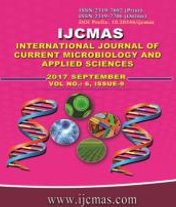


 National Academy of Agricultural Sciences (NAAS)
National Academy of Agricultural Sciences (NAAS)

|
PRINT ISSN : 2319-7692
Online ISSN : 2319-7706 Issues : 12 per year Publisher : Excellent Publishers Email : editorijcmas@gmail.com / submit@ijcmas.com Editor-in-chief: Dr.M.Prakash Index Copernicus ICV 2018: 95.39 NAAS RATING 2020: 5.38 |
Geoinformatics is application of information technology for study and management of earth resources. The salt affected soils of Gohana were mapped and evaluated using visual interpretation of IRS-P6 satellite false colour composite (FCC) image with ground survey and laboratory analysis. A total of 72 soil samples across the study area were sampled based on the quality of groundwater used for irrigation at four depths (0-15, 15-30, 30-45 and 45-60 cm). Long-term irrigation with salt affected water results in soil quality decline. The texture in both normal and salt affected soils was loamy sand to sandy clay loam. The cation exchange capacity, exchangeable sodium percentage, organic carbon and calcium carbonate in normal and salt affected soils of block Gohana varied from 6.81-22.19, 3.18- 20.93 cmol (p+) kg-1; 3.42-13.84, 21.61-72.26 percent; 0.12-0.47, 0.06-0.46 percent and 0.10-1.75, 0.10-7.00 percent, respectively. The electrical conductivity, pH and sodium adsorption ratio of soil saturation extract ranged from 1.26-3.79, 1.44-15.82 (dSm-1), 7.06-8.47, 7.39-9.74 and 2.68-9.06, 5.71-36.85 (mmol l-1)1/2, respectively. A strong correlation was observed between EC and pH, Na+, Ca2+, Mg2+, Cl−, SO42−, ESP, SARe, CEC and clay and saturation percentage and clay. Available nitrogen, phosphorus and potassium were low to medium in both normal and salt affected soils. From satellite imagery, it was observed that out of 2.41% salt affected area in block, 1.13% and 1.28% is moderately salt affected and strongly salt affected, respectively.
 |
 |
 |
 |
 |